India - China: China Targeting India’s Neighbours
STORIES, ANALYSES, EXPERT VIEWS

New details, not known earlier, indicate tensions between India and China along the Line of Actual Control (LAC) continued through 2021 and till end 2022 in the backdrop of the standoff in eastern Ladakh and continued attempts by China to ingress into Indian territory.
The Army presented gallantry awards to personnel for acts of bravery in this regard at two investiture ceremonies held on the eve of Army Day on January 15. One such act involved relaying of live feed from the enemy side in the Sikkim area by a Major-rank officer for 120 hours. Other citations reveal clashes between troops at Shankar Tekri in January 2022 and another clash in November 2022 as the People’s Liberation Army (PLA) troops attempted to lay seize on the Atari post after crossing the LAC.
Speaking of the situation on the northern borders with China, Army Chief General Manoj Pande had said last week that the situation on the northern border is ‘stable but sensitive.’
After the beginning of the stand-off in eastern Ladakh in April 2020, India and China had deployed thousands of troops in forward posts along the LAC in the area which largely continue to remain deployed with the disengagement and de-escalation still incomplete. Both sides have over 50,000 troops that continue to be stationed in the area.
China is willing to use the neighbourhood against India
It is also a matter of concern that China is aggressively wooing India’s neighbours. Difficulties with smaller neighbours are not peculiar to India but one of the variables has changed. In China, writes R Rajagopalan (professor of International Politics at Jawaharlal Nehru University, New Delhi) “India’s neighbours now have an extra-regional power that is both able and willing to use the neighbourhood against India.”
In the past, other than the US and the Soviet Union, now Russia, “China is the other great power that was a potential candidate for intervention in the region to counter India. And it did. In 1965, China attempted to divert Indian military focus on the western front against Pakistan with trumped-up and patently absurd controversies along the Tibet border. India ignored it, and the ploy failed. China did not even attempt any such diversion in 1971 because the People’s Liberation Army (PLA), in the aftermath of the Cultural Revolution, was incapable of presenting any credible diversion to Indian forces. Beijing simply stuck to UNSC resolutions, which in any case went nowhere because of Moscow’s veto.”
China has the capacity to support India’s small neighbours
Thus, writes Rajagopalan “while the Soviet Union and the US had little interest in helping India’s neighbours counter India, China had the willingness but not the capability. This has now changed. China, whose interest in countering India within the South Asian region never flagged, now has the material capacity to support India’s small neighbours..….”
Responding to this challenge is not easy. “For many decades, India could treat its smaller neighbours with relatively benign neglect—or worse—because New Delhi knew they could do little about it. Lacking any capacity to do anything directly against India—Pakistan being an exception—their weakness also made them unattractive to external great powers that had the capacity to help them. Now that they can look to China, the situation is very different.”
That smaller countries such as the Maldives or others would be tempted to play the China card should therefore, “not be surprising. It is logical, rational, and represents the kind of self-interested behaviour that New Delhi frequently invokes, such as in its relationship with Russia or Iran. Responding to such strategic ploys by Male with hyper-nationalism is irrational, useless, and counterproductive…..”
Beyond a point, neighbours cannot annoy India
It is also not in the interest of these small neighbours, argues Rajagopalan “to entirely align with one side or the other, irrespective of what Maldivian President Mohamed Muizzu might say. Even if India, as the proximate power, might represent a greater physical danger than distant China, the primary strategic purpose of these small states is to play India and China off against each other so that they can benefit most from the competition. What this means is that India needs to play this game too, knowing the strategic opportunistic imperatives driving the smaller states as well as their limits. One of these limits is that they live in India’s neighbourhood, which means there are limits that they recognise to how much they can play such games. They cannot, for example, antagonise India beyond a point because there are quite serious punishments that India can impose on them.”
















